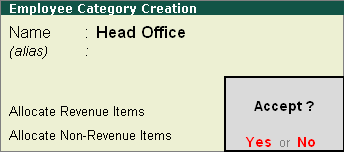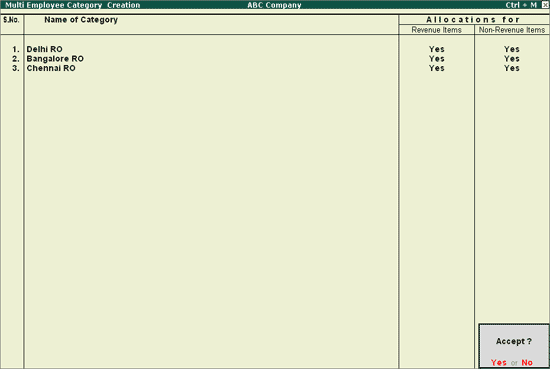Creating Employee Categories (Payroll)
While an Employee Group
is available by default, an Employee Category
provides an additional level of employee classification. An employee category
can be used to track the salaries paid to employees working in specific
projects or locations such as Head Office and Regional Offices.
Note:
The Employee Categories option is available
only if the option Maintain
more than one payroll or cost category is enabled in F11: Accounting features.
Creating a Single Employee Category
To create a single employee category
(for example, Head Office)
Go to Gateway
of Tally > Payroll Info. >
Employee Categories > Create
(under Single Category).
Specify the name
of the category to be added, in the Name
field.
Set the option Allocate Revenue Items to Yes
to allocate revenue related transaction values for employees created
under this category.
Set the option Allocate Non-Revenue Items option to Yes
to allocate non-revenue related transaction values for employees created
under this category.

Press
Y or Ctrl+Y to save the employee category.
Employee Category Configuration
Press F12
to add/remove options in the Employees Category
Creation screen.

Set
the option Allow ALIASES along with the
Names to Yes
to add the alias names.
Set
the option Allow Language ALIASES along
with Names to Yes
to add the names in other languages as selected
(only while using Multilingual
feature).
Set
the option Allow ADVANCED entries in Masters
to No to hide the options Allocate
Revenue Items and Non Revenue Items
in the Employee Category Creation screen.
To create multiple Employee Categories
Go to Gateway
of Tally > Payroll Info. > Employees Categories > Create (under
Multiple Categories).
Enter the employee
category name in the Name of Category field.
Enable the options
Allocations for Revenue
Items and Non-Revenue
Items, if required.
The completed Multi Employee Category
Creation screen appears as shown below:

Press Enter
to save.


